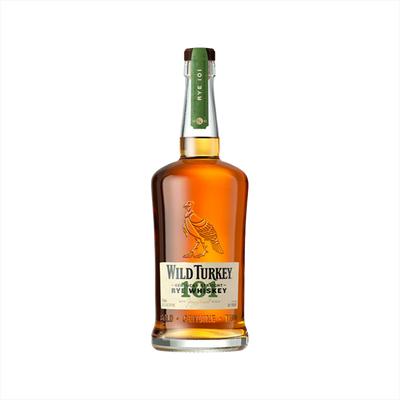Rye-Based Bourbon
What is Rye-Based Bourbon?
Rye-based bourbon is a specific style of Bourbon Whiskey where rye serves as the primary flavoring grain in the mash bill, typically comprising 20-35% of the grain recipe alongside the required minimum 51% corn. This higher rye content creates a spicier, more peppery flavor profile compared to wheated bourbons, delivering notes of cinnamon, black pepper, and baking spices that add complexity and bite to each sip. The rye grain acts as the bourbon's backbone, providing structure and a distinctive warmth that appeals to drinkers who prefer bold, assertive whiskeys with character.
Learn More About Rye-Based Bourbon
What makes Rye-Based Bourbon unique?
Rye-based bourbon stands apart from other bourbon styles through its spicier, more assertive grain bill that must contain at least 51% corn but leans heavily on rye as the primary flavoring grain instead of wheat. This higher rye content delivers a pronounced peppery bite and baking spice character that cuts through the corn's natural sweetness, creating a bolder, more complex whiskey compared to wheated bourbons like Maker's Mark or high-corn mashbills that prioritize smoothness. The rye's influence shows up as cinnamon, clove, and black pepper notes that give these bourbons their signature kick and make them particularly excellent in classic cocktails like Old Fashioneds and Manhattans.
How is Rye-Based Bourbon made?
Rye-based bourbon starts with a mash bill containing at least 51% corn (as required by law) but features rye as the primary flavoring grain, typically making up 20-35% of the recipe instead of wheat. The grains are milled, mixed with water, and heated to convert starches into fermentable sugars, then yeast is added to begin fermentation in large wooden or steel tanks. After fermentation, the liquid is distilled twice - first in a column still, then in a pot still - before being aged in new charred oak barrels at no more than 125 proof, where the rye's spicy character mellows and blends with vanilla and caramel notes from the wood.
How do you drink Rye-Based Bourbon?
Rye-based bourbon shines brightest when sipped neat or on the rocks, where its spicy character and complex grain bill can truly be appreciated without interference. The bold, peppery notes make it a natural choice for classic whiskey cocktails like Old Fashioneds, Manhattans, and Boulevardiers, where the rye's assertive personality stands up beautifully to bitters and vermouth. These spirit-forward drinks are perfect for cooler months and sophisticated evening gatherings, when you want something that warms you from the inside out and sparks good conversation.
How do I choose good Rye-Based Bourbon?
When selecting a rye-based bourbon, look for bottles with at least 15-20% rye in the mash bill if you want that signature spicy bite without losing the bourbon's inherent sweetness—brands like Bulleit and Four Roses offer excellent examples with distinct rye character. For cocktails, higher-rye bourbons shine in spirit-forward drinks like Manhattans and Old Fashioneds where the spice can cut through vermouth and bitters, while lower-rye options work better in sweeter cocktails where you don't want the rye to overpower other ingredients. Always taste neat first to understand the whiskey's personality before mixing, since that peppery rye note will either complement or clash with your chosen cocktail components.
Nutritional Information
Typical Calorie Range per Ounce: 64-70 calories
Typical Carbohydrate Range per Ounce: 0-0.1 grams
Typical Sugar Range per Ounce: 0-0.1 grams
Typically Gluten Free: No
Rye-based bourbons contain gluten proteins from the rye grain used in the mash bill, making them unsuitable for those with celiac disease or gluten sensitivity. While the distillation process removes most gluten proteins, trace amounts may remain. Always check the specific product label and manufacturer information to confirm gluten content, especially if you have severe gluten intolerance or celiac disease.
Scrolled this far? Your reward? Rye-Based Bourbon Trivia!
- The "51% Rule" Creates a Wild West of Flavors: While bourbon only needs 51% corn in its mash bill, high-rye bourbons can contain up to 35% rye grain – that's nearly as much rye as some straight rye whiskeys! This means you could be sipping a "bourbon" that tastes more like rye whiskey than traditional corn-forward bourbon. Brands like Four Roses and Wild Turkey push these boundaries, creating bourbons with serious spice and bite.
- Rye Bourbon Was Accidentally Born from Cheap Grain: High-rye bourbon recipes weren't originally created for flavor – they were born from economics. In the early 1800s, rye was often cheaper and more available than corn in certain regions, so distillers used whatever grain was cost-effective. What started as penny-pinching accidentally created some of the most complex flavor profiles in American whiskey history.
- Your "Smooth" Bourbon Might Actually Be High-Rye: Here's a mind-bender: some high-rye bourbons actually taste smoother than low-rye versions when aged properly. The spicy rye compounds mellow and integrate during aging, creating complexity without harshness. Meanwhile, some low-rye bourbons can taste hot and one-dimensional. It's the exact opposite of what most people expect.
- Rye Bourbon Saved American Whiskey During Prohibition: During the dry years, Canadian distillers kept making high-rye whiskeys that were smuggled into the U.S. When Prohibition ended, American palates had adjusted to expect that spicy rye character. Distilleries that ignored this trend and stuck to pre-Prohibition low-rye recipes often failed, while those who adapted their mash bills to include more rye thrived.
- The Same Distillery Can Make Wildly Different Bourbons Just by Tweaking Rye: Buffalo Trace produces both Eagle Rare (low-rye, around 10%) and Sazerac Rye (95% rye) in the same facility using similar techniques. The difference? Just swapping the grain percentages creates two completely different spirits – one mellow and vanilla-rich, the other fiery and herbal. It's like having two different distilleries under one roof.
Higher-proof spirits can be intense. Mix carefully, taste thoughtfully, and enjoy responsibly.
Gift message (optional)



